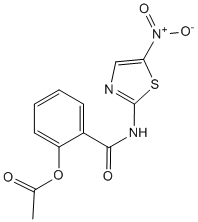All AbMole products are for research use only, cannot be used for human consumption.

Nitazoxanide (Alinia, Annita) is a synthetic nitrothiazolyl-salicylamide derivative and an antiprotozoal agent (IC50 for canine influenza virus ranges from 0.17 to 0.21 μM). The anti- protozoal activity of nitazoxanide is believed to be due to interference with the pyruvate: ferredoxin oxidoreductase (PFOR) enzyme dependent electron transfer reaction which is essential to anaerobic energy metabolism. It has also been shown to have activity against influenza A virus. Nitazoxanide and tizoxanide inhibited virus replication of all canine influenza virus with 50% and 90% inhibitory concentrations ranging from 0.17 to 0.21 μM and from 0.60 to 0.76 μM, respectively.
| Molecular Weight | 307.28 |
| Formula | C12H9N3O5S |
| CAS Number | 55981-09-4 |
| Solubility (25°C) | DMSO 60 mg/mL |
| Storage |
Powder -20°C 3 years ; 4°C 2 years In solvent -80°C 6 months ; -20°C 1 month |
[3] Jos Meneses Caldern, et al. Nitazoxanide against COVID-19 in three explorative scenarios
[4] No authors listed. Nitazoxanide
[5] Jean-Franois Rossignol. Nitazoxanide: a first-in-class broad-spectrum antiviral agent
| Related Anti-infection Products |
|---|
| Strictinin
Strictinin is a phenolic compound which has potential antiviral, antibacterial and laxative activities. Strictinin occurs by accelerating intestinal transit rather than enhancing gastric emptying, increasing food intake, or inducing diarrhea in rats. |
| Torcitabine
Torcitabine (2'-Deoxy-L-cytidine) is an antiviral agent. Torcitabine has the potential for chronic hepatitis B virus infection research. Torcitabine (2'-Deoxy-L-cytidine) shows greater inhibition of first strand than second strand DNA synthesis. |
| ABMA
ABMA is a broad-spectrum inhibitor of intracellular toxins and pathogens. ABMA efficiently protects cells against various toxins and pathogens including viruses, intracellular bacteria and parasite. |
| DDX3-IN-1
DDX3-IN-1 is a DEAD-box polypeptide 3 (DDX3) inhibitor with CC50 values of 50 and 36 μM for HIV and HCV, respectively. DDX3-IN-1 has antiviral activity. |
| K22
K22 is an inhibitor of coronavirus RNA synthesis that specifically targets membrane-associated coronavirus RNA synthesis. K22 effectively blocks replication of multiple coronaviruses by inhibiting the critical step of viral replication complex anchoring to host cell membranes to form double-membrane vesicles (DMVs). K22 exhibits broad-spectrum antiviral activity against diverse coronaviruses. |
All AbMole products are for research use only, cannot be used for human consumption or veterinary use. We do not provide products or services to individuals. Please comply with the intended use and do not use AbMole products for any other purpose.


Products are for research use only. Not for human use. We do not sell to patients.
© Copyright 2010-2024 AbMole BioScience. All Rights Reserved.
